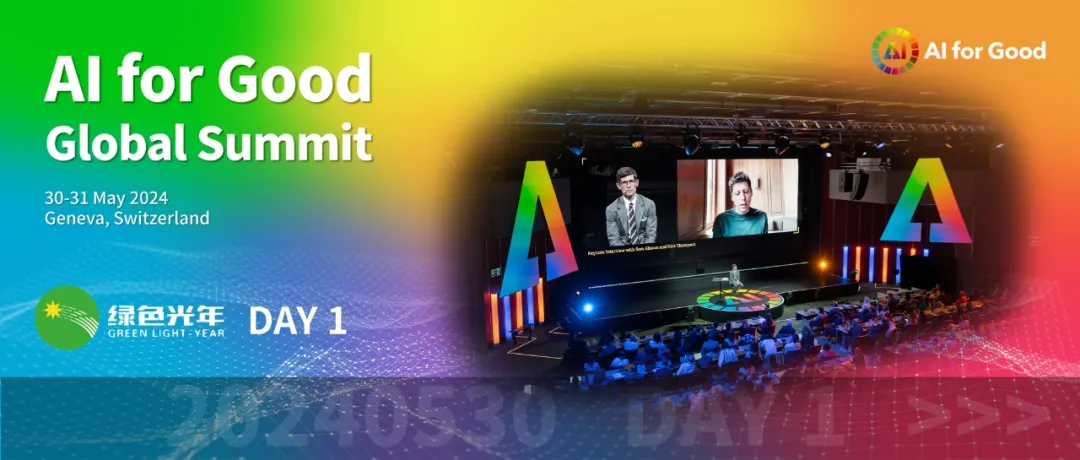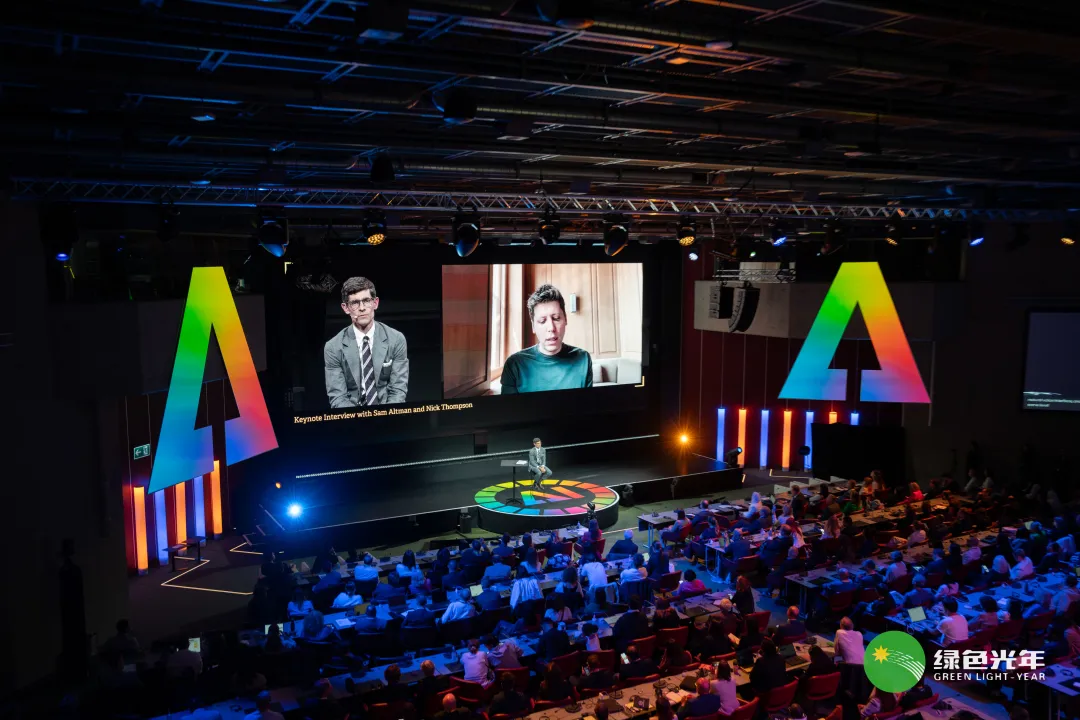
We have less than 10 years to solve the UN SDGs and AI holds great promise to advance many of sustainable development goals and targets.
More than a Summit, more than a movement, AI for Good is presented as a year-round digital platform where AI innovators and problem owners learn, build and connect to help identify practical AI solutions to advance the United Nations Sustainable Development Goals.
AI for Good is organized by ITU in partnership with 40 UN Sister Agencies and co-convened with Switzerland.
This article shares insights from the first day of the GLY Youth Delegation’s participation in the summit.
Featured Photos


Jiazhou Ni
Vice team leader
The AI for Good Global Summit followed the opening of WSIS+20 and was officially launched at CICG, where tech companies and AI technology companies from around the world brought their products and solutions for AI for Good.
Among the exhibits displayed by these companies, we can summarize some simple conclusions: the research direction of language macromodeling is in the hot time; robots used to improve human life tend to focus on a niche area and expect to be the best in that niche area. At the same time, in the exchanges, each company has different trade-offs for arithmetic algorithms and different plans for the future, showing the diversity of the AI field.
The AI for Good Global Summit 2024 transcends the typical boundaries of a conference, spotlighting the most innovative applications of artificial intelligence (AI) in various sectors. In about three weeks, more than 90 interdisciplinary demos will be featured at the AI for Good exhibition floor: from robots and drones to the most advanced brain-machine interfaces. All highlight AI’s vast potential to achieve the United Nations Sustainable Development Goals (SDGs).
This year’s lineup features a wide range of robots and drones, each engineered to support humans when natural hazards strike. In a world increasingly prone to natural disasters, these advanced machines, that can be deployed in hard-to-reach environments on land, in water and air, are set to play a pivotal role in disaster response and mitigation. These robotic systems not only enhance our ability to respond to emergencies but also align with the Sustainable Development Goals (SDGs) such as SDG 9: Industry, Innovation, and Infrastructure and SDG 11: Sustainable Cities and Communities. Their integration into hazardous environment operations underscores a critical evolution in the use of technology for public safety and environmental monitoring.

Kefei Chen
Team member
After visiting the AI for Good exhibition, I deeply felt the existence of the digital divide and the various problems it brings. In today’s rapidly advancing digital and intelligent era, the digital divide is not just a technological gap but also a crucial issue of social equity and inclusiveness.
The Digital Divide Leads to Inequality in Resources and Opportunities
Developed regions and countries possess more advanced technologies and infrastructure, allowing them to quickly access and utilize the latest AI technologies, thereby achieving significant progress in education, healthcare, economy, and other areas. In contrast, underdeveloped areas, due to a lack of technology and resources, cannot enjoy the conveniences brought by these technologies, further exacerbating social inequalities. For instance, children in rural areas may miss out on equal learning opportunities with urban children due to a lack of internet access for online education.
The Digital Divide Limits Overall Social Innovation and Competitiveness
Stagnation in Technological Research: Inequality in resources and opportunities means that some regions and groups find it challenging to access the latest technology and research outcomes. They lack advanced equipment, funding, and educational resources, preventing them from conducting in-depth research and experiments, leading to stagnation in technological innovation. This limitation not only hampers the technological development of these regions but also obstructs global technological progress. For example, universities and research institutions in impoverished areas often cannot afford high-end research equipment or attract top-tier researchers, leading to stagnation in their technological research. Only when more people can participate in technological innovation can we unleash more creativity and solutions. If a portion of the population is excluded from the wave of technological development, it will not only hinder their own development but also restrict the progress and potential development of society as a whole.
Severe Homogeneity of Smart Products in the Market: Due to the concentration of technology and resources, most innovation and R&D activities are centered in a few developed regions and large tech companies. These companies tend to develop products that have already been market-validated to ensure a return on investment, leading to a lack of diversity and innovation in smart products in the market. Homogeneous smart products not only fail to meet the diverse needs of users but also limit the overall vitality and innovative drive of the market. We often see the market flooded with similar smartphones and household smart devices, while truly breakthrough new products are scarce.
Some Companies’ Creativity Remains Only in Blueprints: Limited by resources, technology, and market environment, many companies, especially small and medium-sized enterprises and startups, although possessing excellent ideas and concepts, find it challenging to transform them into actual products. This phenomenon not only wastes valuable creative resources but also buries many potential technological breakthroughs and innovation opportunities. Many innovative ideas, due to a lack of sufficient funding and technical support, can only remain at the concept design and blueprint stage, unable to proceed to prototype development and market testing.
The Necessity of Solving the Digital Divide is Self-Evident
Firstly, bridging the digital divide is a crucial step towards achieving social equity. By providing necessary infrastructure and technical training, we can help more people master and use modern technology, thereby enjoying its various benefits. Secondly, reducing the digital divide also helps enhance the overall innovation capability and competitiveness of society, promoting economic development and social progress. Only when everyone can equally participate in the digital economy can we truly achieve sustainable development goals.
At the AI for Good exhibition, I saw many innovative projects and solutions aimed at bridging the digital divide, such as low-cost internet access devices and educational platforms for underdeveloped regions. These are important steps towards solving the digital divide. I firmly believe that with the joint efforts of all sectors of society, we can certainly narrow the digital divide and let technology benefit more people.

Zihan Gao
Team member
Dr. Olivier Oullier, co-founder of Inclusive Brains, delivered a keynote speech titled “From Special Projects to Scalable Workplace Solutions” at the AI for Good Global Summit. Professor Oullier delved into how AI-driven adaptive human-machine interfaces can enhance inclusivity and safety in workplaces and other environments. He demonstrated how advanced Brain-Computer Interfaces (BCI) and generative AI technologies can enable digital devices and environments to adapt in real-time to people’s emotions and needs, particularly aiding individuals with disabilities.
Product and Technology Overview
1. Brain-Computer Interfaces (BCI)
Overview: BCI is a technology that directly connects the brain to external devices, allowing users to control these devices through brain signals.
Practical Applications: Professor Oullier showcased how BCI technology enables individuals with disabilities to drive real Formula One cars and ignite the Olympic torch using exoskeleton arms. These applications not only demonstrate the sophistication of the technology but also highlight its tremendous potential in improving the quality of life for people with disabilities.
2. Generative AI
Overview: Generative AI creates new content and solutions by analyzing and generating data.
Practical Applications: When combined with BCI, generative AI can adapt in real-time to users’ emotions and needs, enhancing the intelligence of devices and environments. This technology has a wide range of applications, from smart adjustments in home environments to enhancing safety in workplaces.
Social Implications
1. Enhancing Inclusivity
Individual Level: The application of these technologies enables individuals with disabilities to perform daily activities more independently, enhancing their quality of life and confidence.
Societal Level: A more inclusive environment not only facilitates the integration of individuals with disabilities but also promotes harmony and mutual assistance within society.
2. Enhancing Safety
Physical Safety: Adaptive human-machine interfaces can monitor and respond to users’ states in real-time, preventing accidents.
Psychological Safety: These technologies can identify and adapt to users’ emotional states, providing interactions and support that better meet psychological needs.

Jinghan Gao
Team member
During my visit to the AI for Good exhibition, I had the privilege of experiencing cutting-edge products from various countries. Technology companies from around the world gathered to showcase their innovative products and solutions. I observed that these products were not only technologically advanced but also designed with user-friendliness in mind.
At the forum, I engaged with representatives at multiple booths. They enthusiastically introduced their products and patiently answered my questions. This interaction made me appreciate the openness and inclusivity of the tech community and filled me with anticipation for the future of Artificial Intelligence.
A highlight of my experience was the opportunity to engage in conversations with intelligent machines. Through voice recognition and natural language processing technologies, I had smooth interactions with smart robots. This hands-on experience gave me a direct understanding of the practicality and convenience of AI. For instance, I interacted with Navel, an intelligent voice dialogue robot from Navel Robotics. Lively and engaging, Navel eagerly initiated conversations, striving to connect socially. Its responses were warm and reassuring. I later learned that Navel is designed for social interaction, caregiving services, and human-robot dialogue research. When I asked it about climate change, it also provided useful and vivid information.
Today’s learning experience deepened my understanding of AI’s potential to enhance social well-being. I look forward to seeing more technology products that benefit humanity in the future.

Siping Zhang
Team member
Bionic Pet: A Blend of Technology and Warmth
At today’s AI for Good exhibition, a technology product named “Bionic Pet” captured the attention of many attendees. This lifelike robotic pet boasts 30 interactive commands and can respond to gentle strokes, with movements of its head and eyes mimicking real animal behavior.
The Bionic Pet was designed to provide companionship for the elderly, children, and individuals with autism. In modern society, loneliness is a widespread issue, particularly among the elderly and those with special needs. The advent of the Bionic Pet offers a new form of companionship for those in need of care. Highly interactive, it uses built-in sensors and intelligent algorithms to detect the intensity and location of touch, responding accordingly. For instance, when petted gently, it emits a contented “meow,” its head softly sways, and its eyes partially close, as if truly enjoying the affection. Conversely, if treated roughly, it displays discomfort and withdraws, reminding users to be gentle.
Overall, the Bionic Pet is more than just a technological product; it serves as an emotional anchor. By harnessing the power of technology, it brings warmth and companionship to those who need it, showcasing the perfect blend of technology and human care. With continuous advancements, we can expect more products like the Bionic Pet to emerge, bringing greater convenience and warmth to our lives.
